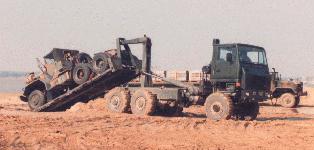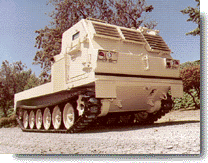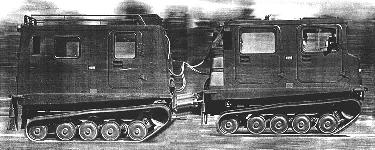

 |
 |
| Medium Transport Vehicle (MTV) | Palletized Loading System (PLS) |
|---|
 |
 |
|
| M1108 Tracked Support Vehicle (TSV) | Small Unit Support Vehicle (SUSV) | |
|---|---|---|
One of the main problems our Army faces today that our presence in Iraq makes much to blunt is that rubber-tired, thin-skinned logistics vehicles have no place on the modern none-linear battlefield. I have greatly been a proponent of the M1108 "Universal Carrier", more familiarly known to those hanging around the 1st Tactical Studies Group (Airborne) as the "Tracked Support Vehicle (TSV)", version of the M113. The TSV is basically an M113 lengthened to 6 road-wheels, the rear hull cut off to save weight and a new cab-over-engine, 3-man cab placed at the front. The M1108 TSV has a curb-weight of just 5,000lbs more than the current 5-ton MTV log truck yet has 50% more weight carrying capacity, 7.5tons, in what I gather is the same approximately 14ft-by-8ft cargo bed. In fact, fully loaded, it can be carried inside a C-130J (I believe, not sure), ready to roll-off as a "self-propelled LOGPAC".
This increased load capacity, armored crew cab, tracked all-terrain driving abilities, commonality with the US Army's currently most prolific armored vehicle, the M113, and smaller size than the
The amphibious issue is a bit tricky since the TSV's max weight is about 40,000lbs, the M113 is not suppose to be loaded more than 32,000lbs and from pictures I've seen of it swimming it is kind-of low in the water, a mere lengthening of the chassis by 2ft isn't going to make much of a difference in trying to float an additional 8,000+lbs. Wile the TSV saves weight by keeping it's cargo bed completely open this will make it's already slim sounding chance of floating kaput, so I first off propose light-weight attachable walls for the cargo bed all the way to the top of the hull and some sort of water-proof tarpaulin too. These walls don't have to be armored or whatnot, just to keep the water out and the TSV afloat. This still will probably not do it completely if the TSV is to be fully loaded and expected to cross a river, so I propose inflatable airbags be attached, running the length and height of the cargo bed walls, to the "walls" and inflated prior to going amphib, to increase displacement / boyancy.
Then there is the issue of a trailer. TSV would have to tow an extra 20,000-25,000lbs and since the M113 (it's parent platform) is not considered the most powerful beast in the Army zoo, the trailer will need to be, at least to some extend, self-propelled. This is blustered by finding on the relevant FAS TSV page that the TSV has a 300hp engine and the relevant FAS MTV page states the MTV has a 290hp engine. This equals a ghestimate of a whopping 15tons extra the TSV's extra 10hp must carry over the MTV. This means that either the TSV should not pull a trailer or only load up to 5tons each on it's own and any future trailer's bed to begin with, have the trailer by (quasi-)self-propelled or that in time it should get perhaps a 500hp (no joke) engine. A possible solution Mike Sparks might offer is a Hybrid-Electric drive which is available for the M113 and it's derivatives and supposedly can produce up to 500hp if needed. The main problem with an HE drive an off-road (witch is where the TSV will be) vehicle can't make that number because - from what I hear - it is only accurate ON-ROAD due to the nature of the HED system.
An other solution is something akin to the SUSV/Bv206 only with both halves being powered. Only a basic hitch would be needed on the new "E(xpanded)TSV" as opposed to the SUSV/BV206's hydraulic steering gear and pass-through drive shaft. Both chassises would be operated by the driver in the main vehicle. Due to a need for a flatter engine in the "TSV Powered Trailer (TPT)" and since the TSV it's self can take up some of the burden, the TPT may be able to get by with a smaller engine than the TSV's, perhaps 100-200hp.
Now to the actual layout of the TPT. It would be a M113 hull reduced in hight to no more than the hight of the track wells. Next it would have it's propulsion system and fuel tank between the track wells so as to have a flush cargo bed above the level of the top of the wells. Next it would have a strengthened 5ton-trailer hitch as well as an electrical hookup for control by the TSV's driver. Finally it would be reduced in length to just 4 road-wheels to give it a 14ft length. It would then have all-around floatation-air-bag equipped cargo bed 'walls' and water-sealed tarpaulin on top. Due to the free-moving nature of the two halves of the ETSV being moved cross-ways by river currents during fording I suggest that 2 bars be able to be attached between the TPT and TSV (permanently attached to the TPT) to "stiffen it" into one, long, vehicle of perhaps 38ft long. These would allow the two halves to freely move vertically relative to each other (for scaling river banks) but not horizontally. It would then seem logical that the TPT could be easily rigged up by a special kit for light transport duties, say for troops or CASEVAC, under it's own power independent of the TSV.
UPDATE! I forgot to mention in the above that the TSV should have a Material Handling Equipment Crane on the front of the TST and something like the Palletized Load System for 14ft beds on both the TST and TSV.